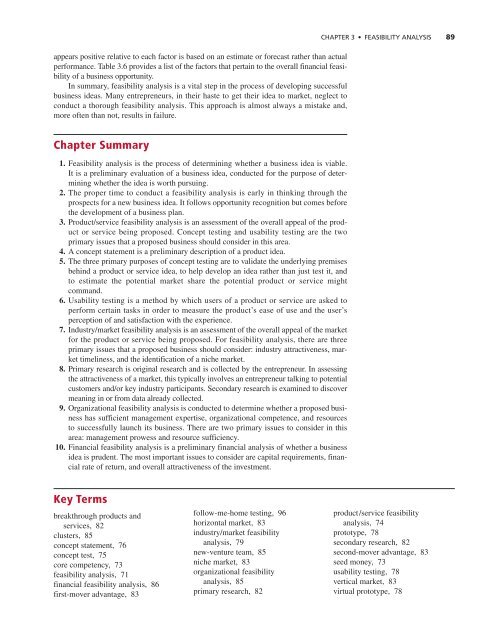feasibility analysis feasibility analysis
feasibility analysis feasibility analysis
feasibility analysis feasibility analysis
You also want an ePaper? Increase the reach of your titles
YUMPU automatically turns print PDFs into web optimized ePapers that Google loves.
appears positive relative to each factor is based on an estimate or forecast rather than actual<br />
performance. Table 3.6 provides a list of the factors that pertain to the overall financial <strong>feasibility</strong><br />
of a business opportunity.<br />
In summary, <strong>feasibility</strong> <strong>analysis</strong> is a vital step in the process of developing successful<br />
business ideas. Many entrepreneurs, in their haste to get their idea to market, neglect to<br />
conduct a thorough <strong>feasibility</strong> <strong>analysis</strong>. This approach is almost always a mistake and,<br />
more often than not, results in failure.<br />
CHAPTER 3 • FEASIBILITY ANALYSIS 89<br />
Chapter Summary<br />
1. Feasibility <strong>analysis</strong> is the process of determining whether a business idea is viable.<br />
It is a preliminary evaluation of a business idea, conducted for the purpose of determining<br />
whether the idea is worth pursuing.<br />
2. The proper time to conduct a <strong>feasibility</strong> <strong>analysis</strong> is early in thinking through the<br />
prospects for a new business idea. It follows opportunity recognition but comes before<br />
the development of a business plan.<br />
3. Product/service <strong>feasibility</strong> <strong>analysis</strong> is an assessment of the overall appeal of the product<br />
or service being proposed. Concept testing and usability testing are the two<br />
primary issues that a proposed business should consider in this area.<br />
4. A concept statement is a preliminary description of a product idea.<br />
5. The three primary purposes of concept testing are to validate the underlying premises<br />
behind a product or service idea, to help develop an idea rather than just test it, and<br />
to estimate the potential market share the potential product or service might<br />
command.<br />
6. Usability testing is a method by which users of a product or service are asked to<br />
perform certain tasks in order to measure the product’s ease of use and the user’s<br />
perception of and satisfaction with the experience.<br />
7. Industry/market <strong>feasibility</strong> <strong>analysis</strong> is an assessment of the overall appeal of the market<br />
for the product or service being proposed. For <strong>feasibility</strong> <strong>analysis</strong>, there are three<br />
primary issues that a proposed business should consider: industry attractiveness, market<br />
timeliness, and the identification of a niche market.<br />
8. Primary research is original research and is collected by the entrepreneur. In assessing<br />
the attractiveness of a market, this typically involves an entrepreneur talking to potential<br />
customers and/or key industry participants. Secondary research is examined to discover<br />
meaning in or from data already collected.<br />
9. Organizational <strong>feasibility</strong> <strong>analysis</strong> is conducted to determine whether a proposed business<br />
has sufficient management expertise, organizational competence, and resources<br />
to successfully launch its business. There are two primary issues to consider in this<br />
area: management prowess and resource sufficiency.<br />
10. Financial <strong>feasibility</strong> <strong>analysis</strong> is a preliminary financial <strong>analysis</strong> of whether a business<br />
idea is prudent. The most important issues to consider are capital requirements, financial<br />
rate of return, and overall attractiveness of the investment.<br />
Key Terms<br />
breakthrough products and<br />
services, 82<br />
clusters, 85<br />
concept statement, 76<br />
concept test, 75<br />
core competency, 73<br />
<strong>feasibility</strong> <strong>analysis</strong>, 71<br />
financial <strong>feasibility</strong> <strong>analysis</strong>, 86<br />
first-mover advantage, 83<br />
follow-me-home testing, 96<br />
horizontal market, 83<br />
industry/market <strong>feasibility</strong><br />
<strong>analysis</strong>, 79<br />
new-venture team, 85<br />
niche market, 83<br />
organizational <strong>feasibility</strong><br />
<strong>analysis</strong>, 85<br />
primary research, 82<br />
product/service <strong>feasibility</strong><br />
<strong>analysis</strong>, 74<br />
prototype, 78<br />
secondary research, 82<br />
second-mover advantage, 83<br />
seed money, 73<br />
usability testing, 78<br />
vertical market, 83<br />
virtual prototype, 78

















